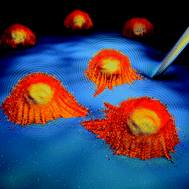How far cardiac cells can see each other mechanically†
Abstract
We ask the question whether cardiac cells, separated by a soft solid medium, can interact with one another mechanically, and if so, then how does the interaction depend on cell–cell separation, and the stiffness of the medium. First, we show that cardiac cells can be stimulated by a mechanical signal alone. We culture primary chicken embryonic cardiomyocytes on a 2D soft substrate. A mechanical probe is used to apply local cyclic stretch on the substrate near quiescent cells (cells not beating). Within 10 cycles of stretch, the cells begin to beat, and continue to do so for hours after the stimulation, while control non-beating cells remain quiescent. Next, we show that a beating cardiac cell (instead of the probe) can stimulate a neighbor. Our 2D culture of cardiomyocytes on a deformable soft substrate (0.5–1 kPa) shows that closer the cells are as a pair, higher is the probability of both of them beating over longer time. This probability is much higher than that of both cells beating as a pair when they are cultured on a harder substrate (47 kPa), or the probability of a single cell beating on the same soft substrate (0.5–1 kPa). The cell–cell interaction, namely, the stretch induced by one contractile cell onto another is modeled using the principles of continuum mechanics. The close correspondence between the predicted cell–cell interaction and the experimental observations suggests that cardiac cells are mechanically coupled through the deformable substrate, and that the coupling decreases with increasing distance between them and the substrate stiffness. The quantitative analysis and the experimental results provide a biophysical basis for the understanding of cell–cell interaction in cardiac tissue through the deformation field of the in vivo soft microenvironment.


 Please wait while we load your content...
Please wait while we load your content...